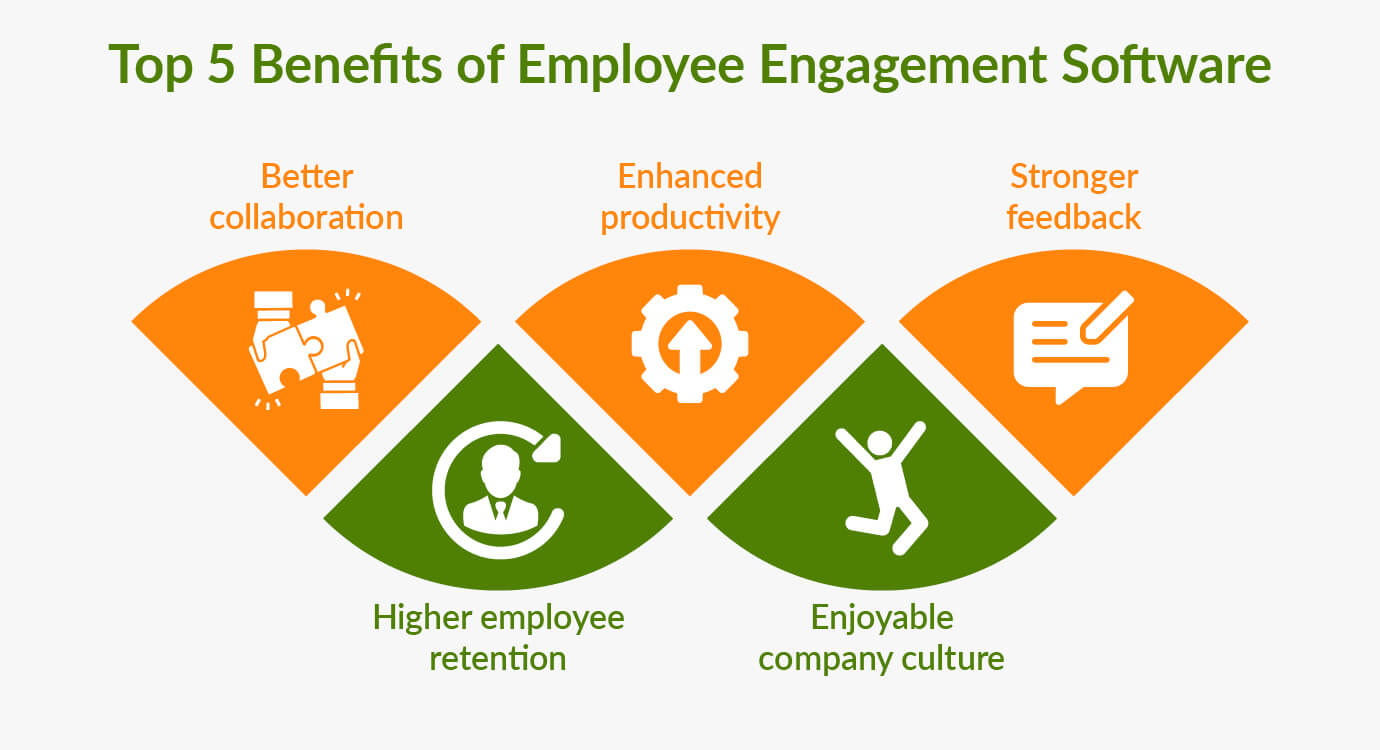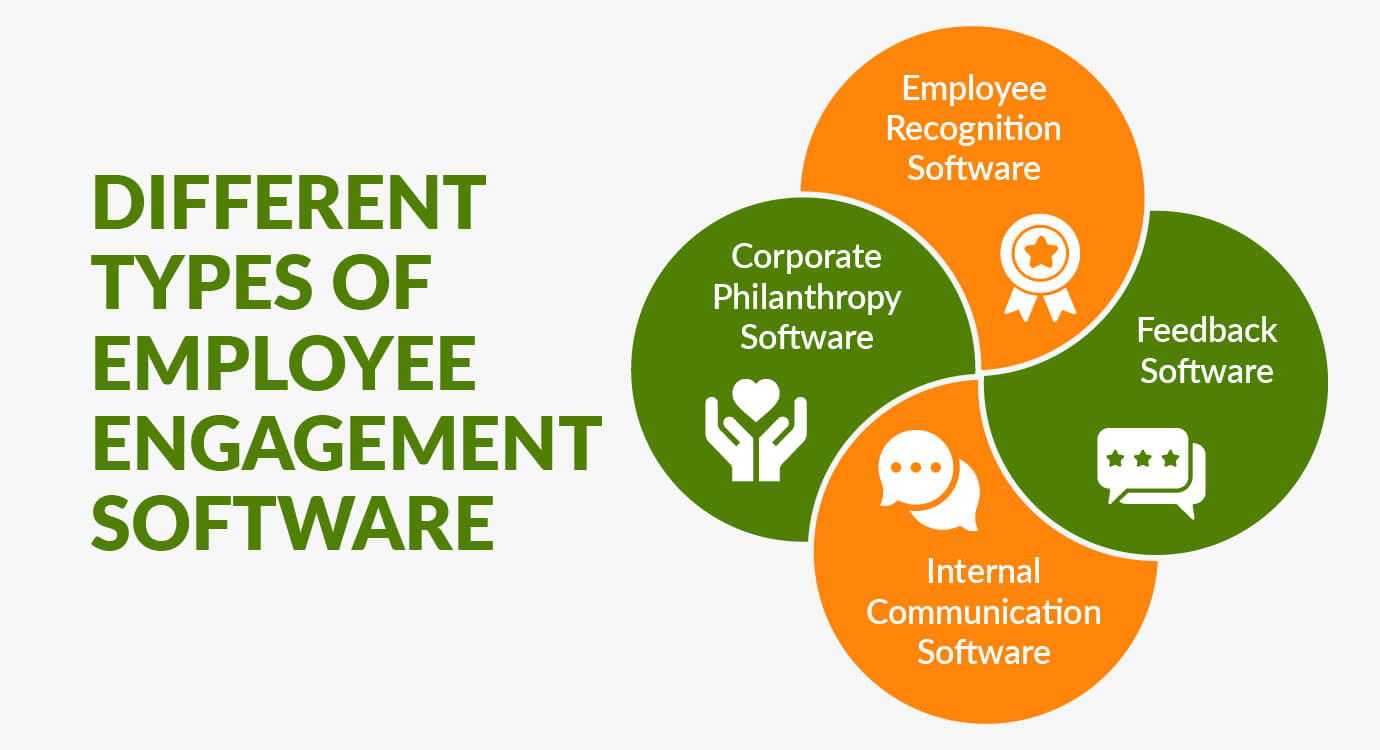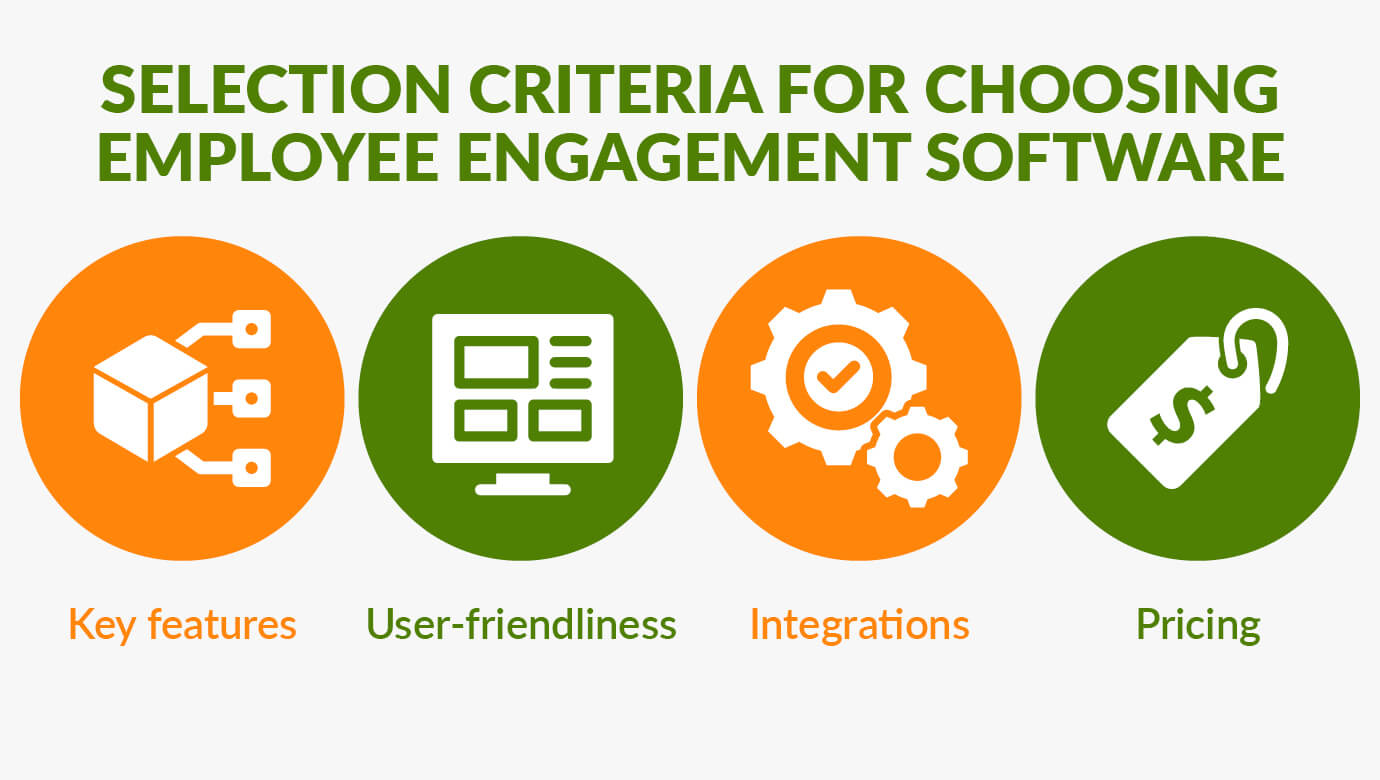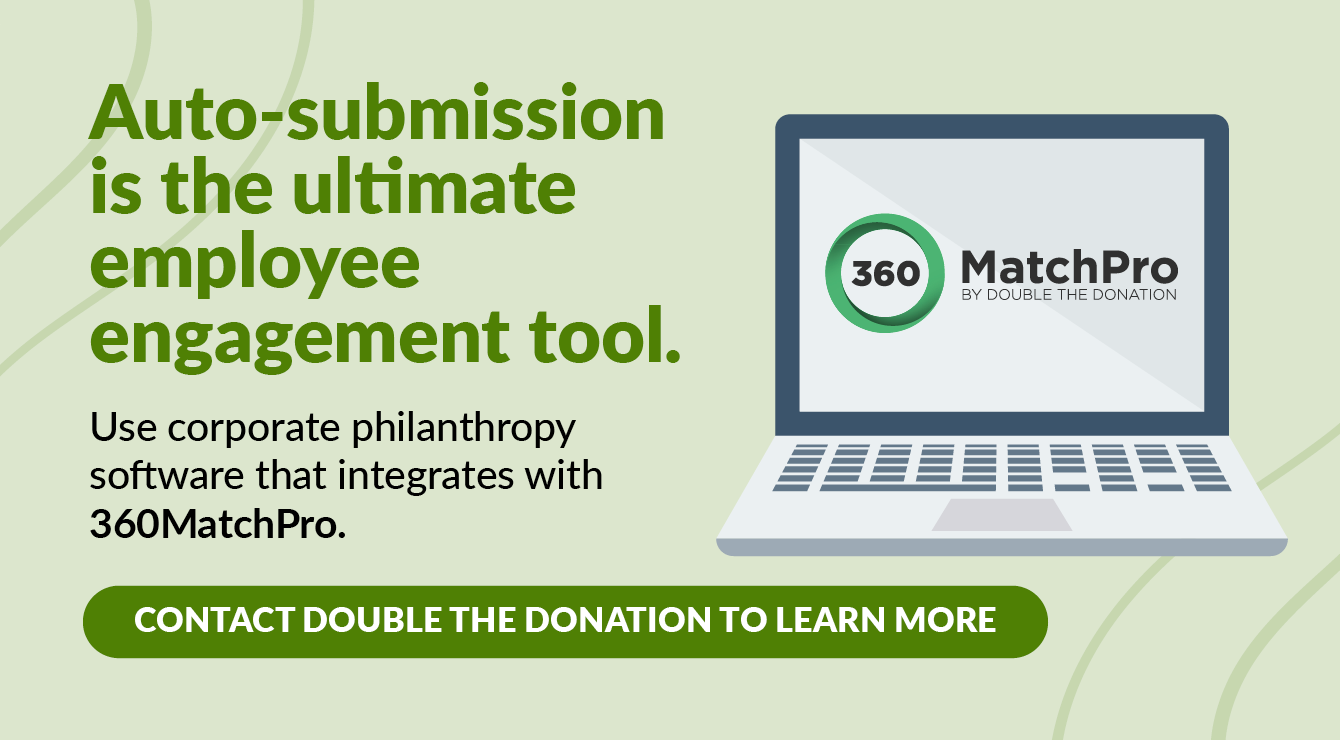Did you know that employee engagement in the United States has been declining over the past couple of years? For the first time in a decade, the employee engagement rate decreased from 36% in 2020 to 34% in 2021, with an even further decrease to 32% in 2022.
What does this mean for businesses, though? Research shows that the price companies pay for actively disengaged employees is between $483 and $605 billion per year. Think about what organizations could do with all that extra money.
Most companies like to think they’re engaging their employees effectively, but it’s easier said than done. To ensure you’re actively prioritizing employee engagement, you need to use dedicated employee engagement software.
In this article, we’ll answer the top questions organizations have about implementing employee engagement software, including:
- What Is Employee Engagement Software?
- What Are the Benefits of Employee Engagement Software?
- How Can You Use Employee Engagement Software?
- What Are the Selection Criteria for Choosing Employee Engagement Software?
- What Are Other Ways to Increase Employee Engagement?
When you use employee engagement software, you show your team that you’re committed to finding solutions that not only enhance the business but also the employee experience. Follow along as we explore employee engagement software and what it can empower you to accomplish.
What Is Employee Engagement Software?
Employee engagement software refers to any tool or solution that helps employees do their best at work and feel more connected to the workplace. The goal of this software is to keep employees happy and productive so they work at their highest potential and contribute to a positive work environment.
While the features of employee engagement software differ from tool to tool, examples include training tools, surveys, notification systems, and integrations with other tools.
What Are the Benefits of Employee Engagement Software?
Employee engagement is a very general term that encompasses a variety of different concepts related to workplace performance. That’s why there are so many potential benefits of using employee engagement software, including:

- Better collaboration. Many employee engagement solutions facilitate team collaboration and the flow of ideas.
- Higher employee retention. When your employees are engaged in their work, they’re more likely to be satisfied with their jobs. As a result, they’ll stick around at your company for longer.
- Enhanced productivity. Since these tools help employees work together, they can increase efficiency and keep everyone on task. In fact, high employee engagement results in a 14% increase in productivity, demonstrating the power these tools can have to transform your business.
- Enjoyable company culture. Employees will enjoy the workplace more when they can communicate with their coworkers effectively and receive praise for their hard work. Employee engagement software helps make this possible.
- Stronger feedback. While verbal feedback is useful, it’s perhaps even more advantageous to have a system where you can gather and store feedback between employees and managers, as well as between peers in the workplace.
Even if your organization already has systems in place with these benefits, employee engagement software formalizes the process of workplace communication and satisfaction.
How Can You Use Employee Engagement Software?
There are different types of employee engagement for different purposes. Start by determining your goal for using the software. For example, the software you use for properly recognizing your employees for their work will look very different from the software you implement if you’re trying to improve internal communication. Then, seek out one of the solutions we’ve outlined below.
Using Employee Engagement Software for Employee Recognition
You likely recognize high-performing employees with compensation changes, bonuses, and occasional praise. While these methods can definitely reinforce good performance, employee engagement software can help employees feel appreciated on a more regular basis.
There are three main categories of employee recognition you can leverage with a software tool:
- Managerial recognition. Managers can use employee engagement software to recognize employees when they’re exceeding expectations. That way, employees will know they’re on the right track and will feel motivated to continue working hard.
- Peer-to-peer recognition. Sometimes, peer-to-peer recognition can be even more valuable to employees than managerial recognition. When your peers notice you’ve stepped up on a project or have completed a task with ease, their recognition can be very powerful in making employees feel appreciated in the workplace.
- Leadership recognition. Let’s say an employee has contributed to a company-wide initiative in a significant way. Company leadership may want to recognize this individual for their contributions, even if they don’t directly work together.
Employee engagement software can be used for all types of employee recognition. One of the most impactful employee engagement solutions for employee recognition is eCard software. Many companies use eCards to recognize employees when they exemplify a company value. For example, one of your company’s values may be to communicate efficiently with clients. If one of your employees quickly solves an issue with a client, then another team member can send them an eCard to show they appreciate their commitment to what your business stands for.
You can even customize these eCards to include your company’s branding. Then, add some text and send them out to your hard-working employees!
Other employee engagement software allows you to reward employees for their hard work. These platforms typically allow employees to earn badges and points for specific actions that they can redeem for real prizes. Alternatively, some platforms allow you to directly send gifts and gift cards to employees you want to recognize.
Using Employee Engagement Software for Feedback
Just as employees want to be recognized when they perform well, they also benefit from constructive feedback. However, with 36.2 million Americans projected to be working remotely by 2025, it can be more difficult to offer employees regular feedback without a dedicated solution.
Plus, employees should be able to give their input on the companies they work at as well. When you use feedback-based employee engagement software, you allow employees the chance to report on their experience in the workplace and submit any suggestions they have for improvement.
That way, you can implement any changes that would improve the workplace and assure employees that their voices are being heard. As a result, you can stay on top of employee concerns and prevent people from quitting without first trying to resolve any issues they may have.
Many of these platforms have features that streamline the performance management process. While some platforms allow you to conduct performance reviews directly through the platform, others compile past feedback so employees and managers can have it handy for performance management meetings. Additionally, some platforms allow you to input company goals so team members can reference them when they’re giving or receiving relevant feedback.
Using Employee Engagement Software for Internal Communication
Nothing blocks progress like a lack of communication. Whether you’re onboarding a new employee or collaborating on an important project, internal communication is key to relaying any necessary information, answering questions, and moving items to completion.
Employee engagement software can streamline internal communication and make it easy to chat back and forth with coworkers. Save email for longer, more formal communications and opt for employee engagement software for quick, seamless messaging. If you want to discuss an issue or hold a meeting, you can use employee engagement software to hop on a call from anywhere.
An issue some businesses run into with internal communication is using email and other messaging tools for task management. This practice can lead to tasks getting lost and can make it difficult for employees to track task progress and completion.
To solve this problem, use an employee engagement software solution that’s geared toward project management. Look for a platform that allows you to input and assign tasks to different employees. Then, employees can track the status of each task, when it’s due, and how much time they’ve spent on it. Most of these platforms allow team members to customize their view so they can sort tasks by categories such as due date, task type, or status.
Using Employee Engagement Software for Corporate Philanthropy
One of the most common forms of corporate philanthropy is matching gifts. If you’re not familiar, matching gift programs involve employers matching their employees’ donations to nonprofits. As a result, nonprofits can double or even triple their donation revenue.
Starting a matching gift program increases employee engagement because it helps employees feel a greater connection to their employer. When companies are committed to helping the causes their employees care about, these employees feel heard and appreciate the positive impact their employers are making.
To facilitate matching gifts, use a matching gift-specific employee engagement solution. This type of platform should allow you to:
- Track employee donations. Instead of managing employee donations on your own, you can use a platform that compiles all employee donations in one place.
- Accept matching gift requests. When you establish a matching gift program, you’ll develop requirements such as minimum and maximum match amounts that determine a donation’s match eligibility. Employee engagement software allows you to automatically approve eligible matching gift requests or opt for manual approval.
- Encourage employees to give back. Donors are 84% more likely to donate to the causes they care about if they know their employer will match that donation. With corporate giving software, you can facilitate the matching gift process and encourage your employees to support their favorite causes.
- Measure your impact. The best employee engagement software for corporate philanthropy provides real-time reporting so you can keep track of how much you’ve contributed to charitable causes.
- Use matching gift request auto-submission. On the nonprofit side, the biggest hold-up to obtaining matching gifts is employees not sending matching gift requests to their employers. To streamline this process, use employee engagement software that integrates with auto-submission tools. That way, all employees have to do is enter their corporate email addresses, and the software will automatically submit requests to employers on the donors’ behalf.
In addition to matching gifts, another popular type of workplace giving is volunteer grants. Instead of matching donations to a nonprofit, volunteer grants allow companies to contribute to the causes their employees care about depending on how many hours they’ve volunteered.
When you use employee engagement software intended to manage volunteer grant programs, you can easily promote any local volunteer opportunities, track the number of volunteer hours employees log, and manage volunteer grant requests.
What Are the Selection Criteria for Choosing Employee Engagement Software?
Now that you’ve determined which type of employee engagement software you’re looking for, you may be wondering how you can tell which specific provider is right for your organization’s needs. We’ve developed some selection criteria so you can choose the best employee engagement software option:
- Key features. Depending on what you’d like to accomplish with your employee engagement software, certain features may be crucial to have in your engagement solution. For example, if you’re looking for employee recognition software, you may prioritize a platform that notifies an employee’s manager when that employee receives recognition from a peer.
- User-friendliness. To truly maximize employee engagement, opt for a platform that’s easy for people to use. That way, employees will actually use the platform and reap the benefits. See if any platforms offer a free demo or trial so you can test them out before purchasing them or introducing them to your team.
- Integrations. Employee engagement software works best when it integrates with the tools your organization already uses. For example, if your company uses Google Workspace, you’ll want to invest in a platform that seamlessly integrates with Google’s applications.
- Pricing. One of the most important considerations when you’re choosing a platform is cost. Most employee engagement platforms charge customers on a per-user per-month basis. Compare pricing options, and check to see which solution will provide the best value before making your decision.
Once you select a platform, don’t forget to train your employees on how to use it. Hold a meeting introducing the new tool and how the business will implement it. Then, answer any questions team members may have so they can start integrating the tool into their operations.
What Are Other Ways to Increase Employee Engagement?
Imagine this: You’ve implemented your employee engagement software. Three months later, you survey employees, and they indicate that the platform helps them complete their work and feel a better sense of connection to their co-workers. However, you want to keep this momentum going by increasing employee engagement even further.
Luckily, there are other ways you can increase employee engagement that work perfectly in tandem with your software solution. Check them out below:
- Prioritizing employee wellness. According to Statista, 79% of employees believe their company’s wellness programs aid their productivity. When employees feel better, they work better, too. Show your employees you care about their well-being by offering time off for mental health days and respecting their work-life boundaries. You can also encourage wellness in the office by providing healthy snacks, standing desks, and outdoor meetings.
- Updating your compensation policy. Compensation should go beyond just payroll. Adopt a holistic compensation approach by offering a variety of benefits, such as extensive paid-time-off (PTO) policies, health insurance, bonuses, remote work opportunities, professional development opportunities, and upward mobility. That way, there are multiple incentives to motivate employees to do their best work.
- Providing team-building opportunities. Team cohesion is key to making sure everyone is engaged in the workplace. Give back to your community by organizing a volunteer outing for your employees. When team members work toward a common goal, they can apply that sense of collaboration to the office. You can also host a company retreat so employees can get to know each other outside the office.
When you combine these tactics with your employee engagement software, you’ll maximize employee engagement, resulting in a more positive, productive work environment.
Additional Resources
With the right employee engagement software, you can help your team work more efficiently and effectively. Remember to determine your employee engagement goals, compare software options, and choose the one that suits your team’s needs the best.
Want to learn more about encouraging employee engagement? Check out these resources:
- Workplace Giving Software: The Ultimate Guide for Companies. Interested in diving deeper into workplace giving software? This guide provides several options for solutions that leverage corporate giving to increase employee engagement.
- A Complete Guide to Remote Employee Engagement: 6 Strategies. Are you struggling to figure out how to make remote employees feel like equal members of the team? Check out this article to help boost remote employee engagement.
- Top 10 Employee Recognition Software for Any Organization. If you’re looking for employee engagement software intended for employee recognition, you’ve come to the right place. This article reviews the top employee recognition software solutions your team can leverage.

